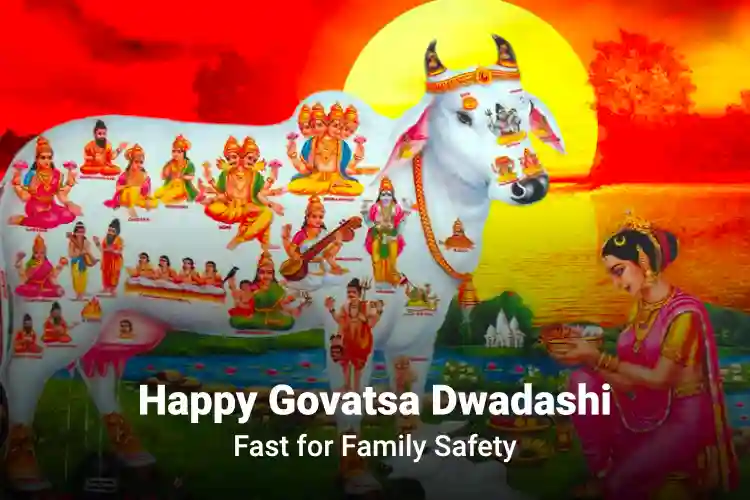Govatsa Dwadashi And Vasu Baras Meaning And Importance
Govatsa Dwadashi is a one-of-a-kind Hindu festival dedicated to worshipping cows as a thank-you gesture for their assistance in maintaining human life. It is also known as ‘Nandini Vrat,’ and is observed on the ‘Dwadashi’ (12th day) of the ‘Krishna Paksha’ (the waning phase of the moon) in the ‘Ashwin’ month of the Hindu calendar. In the English calendar, this date comes between the months of October and November. Govatsa Dwadashi occurs one day before the ‘Dhanteras’ festival.
Hindu devotees worship ‘Nandini,’ the sacred cow, during Govatsa Dwadashi. It is thought that by doing so, all of their wishes will come true. It is widely observed and celebrated in all sections of the country. This day is known as ‘Vasu Baras’ in Maharashtra and is the first day of the Deepavali celebrations. The ‘Sripada Vallabha Aradhana Utsav’ is conducted at Pithapuram Datta Mahasamsthana in the state of Andhra Pradesh on Govatsa Dwadashi, whereas it is known as ‘Vagh Baras’ in Gujarat.
Vasu Baras Meaning – The day is recognised for honouring cows and calves and is observed on the twelfth light of day of the Krishna Paksha of the Ashwin calendar month, according to the Maharashtrian calendar. Vasu Baras is derived from the words ‘Vasu’ meaning (cow) and ‘Baras’ meaning (twelfth day).
Govatsa Dwadashi 2025 Date
In 2025 Govatsa Dwadashi will fall on 17 October 2025, Friday as mentioned, a day before Dhanteras.
| Pradoshkala Govatsa Dwadashi Muhurat – 06:05 PM to 08:30 PM Duration – 02 Hours 25 Mins Dwadashi Tithi Begins – 11:12 AM on Oct 17, 2025 Dwadashi Tithi Ends – 12:18 PM on Oct 18, 2025 |
Govatsa Dwadashi Significance
The ‘Bhavishya Purana’ mentions the significance and mythology of Govatsa Dwadashi. The narrative of Nandini, the Divine cow, and her calves is also told in the purana. Cows are considered sacred in Hinduism. They are even revered as sacred moms since they provide nutrition to the human race. Women fast on Govatsa Dwadashi in order for their children to live a long life. It is widely believed that if a childless couple devotes themselves to the Govatsa Dwadashi puja and fasts, they would be blessed with a child.
Govatsa Dwadashi is also known as ‘Vagh‘ in some parts of Northern India, which means ‘repaying one’s financial debts.’ As a result, business people clear their accounts books on this designated day.
Govatsa Dwadashi Rituals
- On Govatsa Dwadashi, cows are venerated. Vermillion is put to the forehead after a ritualistic wash. The cows and their calves are then elegantly dressed and adorned with a garland of flowers.
- If they can’t find a cow nearby on Govatsa Dwadashi, devotees build mud idols of cows and their calves. After that, kumkum and turmeric are applied to the mud idols. In the evening, a ‘aarti’ is performed.
- Cows are offered gram and sprouted moong, among other things. The contributions represent Nandini’s presence on Earth.
- Devotees also pray to Sri Krishna, who is an incarnation of Lord Vishnu and is known for his deep gratitude and affection for cows.
- On this day, women observe a vrat, or fast, for the sake of their children’s health.
- The Nandini Vrat observer must refrain from physical exertion and remain vigilant throughout the night.
- On the day of Govatsa Dwadashi, some individuals refrain from drinking cow’s milk and eating curd and ghee.
Worried about the rituals and Puja Vidhi? Consult an Astrologer Now!
Vasu Baras Celebration – Significance Of Cow Puja
Cow mother, according to Hinduism, is the most important pilgrimage of all. A cow also gains the status of mother and cannot be likened to any deities or pilgrimages.
People believe that if a person aspires to satisfy all of the deities as well as his or her ancestors, there is no rite greater than cow devotion or cow service.
It is thought that food offered to cows reaches the gods directly. Women fast totally and truly on Bach Baras or Govatsa Dwadashi for their sons’ well-being, long lives, family bliss, and to be blessed with a son.
Govatsa Dwadashi Katha – Legend Of Govatsa Dwadashi
In ancient times, there was a kingdom known as Suvarnapura. The monarch of this kingdom was Devdani. He had a buffalo, a calf, and a cow. He had two queens, Sita and Geeta. While Sita adored buffalo, Geeta adored the cow and calf.
A buffalo once complained to queen Sita that Gita did not love her. Sita killed the cow’s calf and buried it in a stack of wheat. The king one day sat down to dine and it started raining blood and body parts of the cow. The food on the platter transformed into faeces, and the monarch became worried.
He heard a voice saying that queen Sita had killed the cow’s calf and that’s why this calamity had occurred. The horrified king inquired as to how he might atone for his wrongdoing. The voice told him to slaughter a buffalo on Govatsa Dwadashi, the next day. If he would avoid eating chopped fruits and drinking milk he would get atonement from sin, and the calf will come to life.
The king did as told and the calf got back to life and the king immediately ordered everyone to observe the Govatsa Dwadashi fast.
Govatsa Dwadashi 2025 Vrat
Women fast for their sons’ well-being and excellent health, as well as to be blessed with a son. On this day, women make wet clay idols of cows, calves, tigers, tigresses, and other animals, place them in a single location, and worship them according to the rituals.
You Can Empower Your Fortune With Special Puja On Festivals – Get Your Get First Consultation Free
With Ganesha’s Grace,
The GaneshaSpeaks Team



